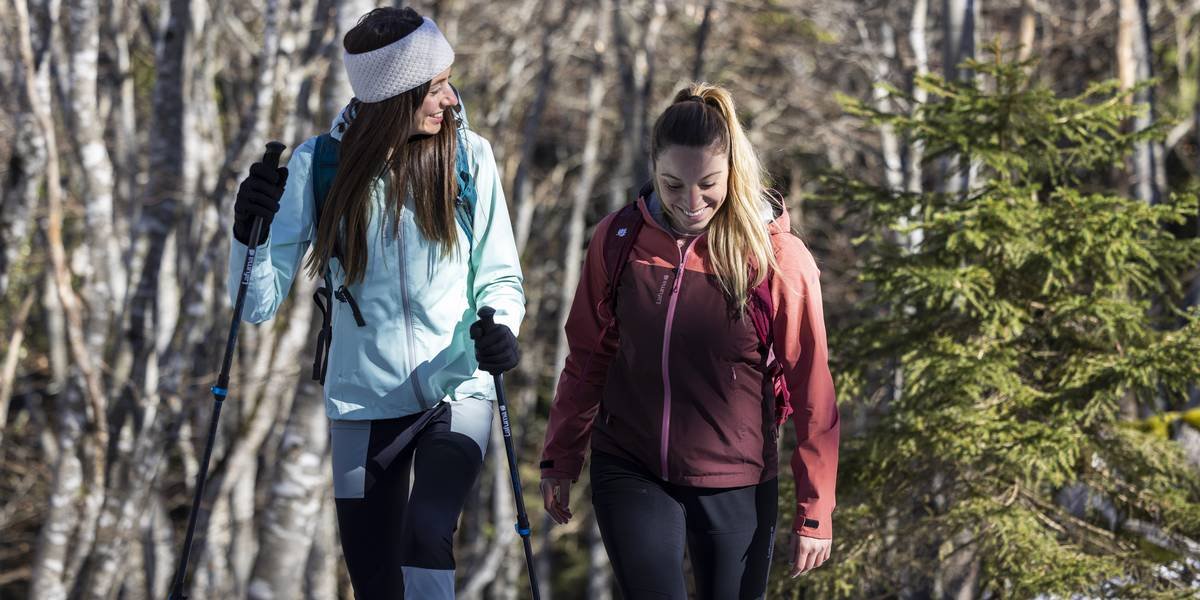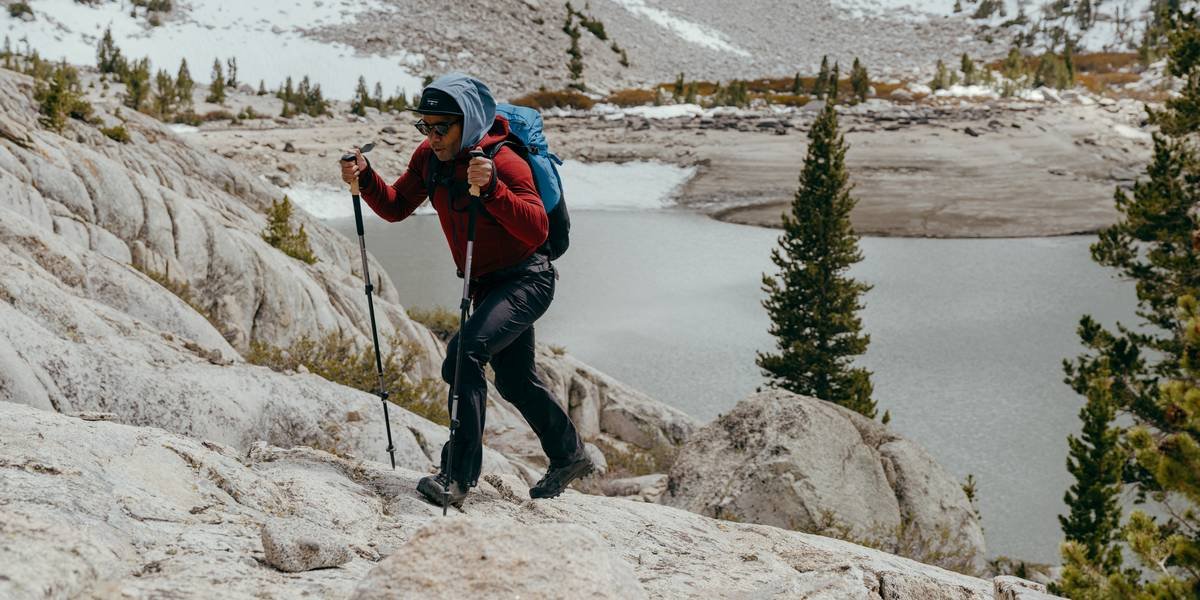In recent years, the market for hiking poles has been booming, with an ever-growing range of options available at all price points. Trekking poles play a crucial role in maximizing your effort on the trails. When purchasing, you’ll choose your poles based on factors such as the number of sections, the adjustment mechanism, and the type of tips and handles, among others. Here is a comprehensive guide to help you make the right choice in an increasingly diverse and innovative market.

What are the benefits of using walking poles for hiking?
After being considered cumbersome and useless, they are now on the list of standard hiking equipment items for any hiker, on the same level with footwear, backpacks, and clothes. Better stability, less muscle fatigue, improved performance are the arguments in favour of this piece of equipment. From recreational hikers to athletes, everyone has switched to using them and no one is willing to go back. Using walking poles is a great way to recruit more muscle groups when hiking, reducing the stress on your body when carrying heavy loads. Trekking poles allow you to engage your upper body more. It can also be a solution for people who suffer from knee pain, especially on the descents.
The various types of walking poles
Fixed-length or non-adjustable poles
Very similar to standard alpine skiing poles, fixed-length poles provide performance and strength on your hikes. Simply make sure they are the right length to fully enjoy their benefits. However, it is impossible to carry them in your backpack, making them mostly suitable for recreational use. Most serious hikers will prefer adjustable or foldable poles like the ones we’ll cover now.
Adjustable poles
Nowadays, adjustable poles are very common in specialised stores. Their sections easily collapse into each other. They are easy to adjust and to attach to your backpack when you don’t need them. You can adapt the length of the pole according to the situation you’re in. Sturdy and practical, they’re the perfect hiking poles for intensive use. The only shortcoming is that if the locking mechanism relies on a screw, you need to carry a small screwdriver with you. Because of shocks and vibrations, it can loosen and the pole may collapse under your weight.
Foldable poles
Also popular on the market, they are often meant for trail runners, as well as experienced hikers, looking for an efficient and practical pole. Often made of 3 sections, connected by a wire inside the shaft, foldable poles have a small footprint in your backpack. Often made of carbon, they have the advantage of being ultra-light, stiff and absorbing vibrations on rugged terrain. A foldable walking staff is perfect for those who prioritises weight and performance.

The criteria to choose the best walking poles
Number of sections
We just covered the pros and cons of various walking pole models. It is indeed the first thing to consider. To sum it up, while adjustable and foldable poles are practical, efficient and meant for advanced users, fixed-length poles are not as practical, heavier but robust and reliable on any terrain. It's up to you to define your priorities to make the right choice.
Walking pole locking mechanism
You’ll find various systems on the hiking poles available on the market:
Plastic lever locking mechanism: this system offers the best ratio of performance and practicality on the market. When loosed, the sections collapse into each other to reach the suitable length. Then, the levers secure the pole length. This system is quick to use, even when moving.
Twist lock: just as before, the sections collapse into each other, but in this case a simple twisting motion locks the pole. This very practical solution can be unreliable for intensive use as the sections may loosen due to repeated vibrations. The twist lock system is perfectly suited to easy hikes on hilly and fast rolling terrain.
Magnetic or metal push-button lock: this system is often used on foldable poles. Very useful to collapse the sections, this system may show its limits on winter hikes in cold and snowy conditions. Snow in contact with the pole can freeze and make folding difficult.
Trekking pole minimum and maximum length
If the question is irrelevant when it comes to non-adjustable poles, it is one you should consider when buying trekking poles that are adjustable. While this may seem secondary, make sure the minimum length fits in your hiking backpack and the maximum length isn’t too short for you. This point concerns mostly taller hikers, but it can’t hurt to check before buying!
Weight and materials
Carbon walking poles: good for weight and vibration absorption
Carbon trekking poles are generally high-end poles. Depending on the models, a pair can weigh between 350 g and 500 g. While this type of equipment is ultra-light and stiff, it can break and can’t be repaired when damaged. They are also more expensive compared to other models on the market. Finally, carbon poles are primarily selected by hikers looking for minimal weight and great walking comfort thanks to their absorbing capacity.
Aluminium hiking poles: good for ruggedness and value
Aluminium poles are heavier than carbon poles. Weighing between 500 g and 650 g, they are however more durable. Difficult to bend, aluminium will better withstand the test of time and the stress of pole plants. However, they are more prone to vibrations than carbon models, making them less comfortable on long hikes. An aluminium trekking pole is the perfect choice for hikers looking for a reliable model, ready for any situation.
Summary Table: How to Find the Right Hiking Pole?
| Pole Type | Features? | Pros | Cons | Average Weight | Recommended Use |
|---|---|---|---|---|---|
| Fixed-length Poles |
- Resemble alpine ski poles - Fixed length, non-adjustable - Cannot be folded or stored in a backpack |
- Sturdy and effective - Simple to use (no adjustment needed) |
- Cannot be stored in a backpack - Lack of adjustability - Less versatile |
Variable, depending on the material used |
- For occasional use - Ideal for those seeking simplicity |
| Telescopic Poles |
- Consist of several sections that interlock with each other - Locking system (often screw-based) allowing for length adjustment |
- Easy to adjust and adapt to the terrain - Can be attached to a backpack - Sturdy and practical for intensive use |
- The screw system can loosen with impacts |
Generally between 400 g and 600 g per pair |
- Hikers and trekkers - intensive use - Ideal for those seeking a versatile pole |
| Folding Poles |
- Often composed of 3 sections connected by an internal cable - Fold quickly, minimal footprint - Widely used by trail runners and experienced hikers |
- Very compact once folded - Light and high-performing - Great rigidity, good vibration absorption (often made of carbon) |
- Often more expensive - Less adjustable in length than telescopic ones (although hybrid versions exist) |
Very light (often around 350 g to 500 g) |
- Trail running, speed hiking, or mountain use - Perfect for those seeking lightness and compactness |
| Carbon Poles |
- Often high-end poles - Very good rigidity - Vibration absorption |
- Lightweight poles - Superior walking comfort - Excellent shock absorption and reduction of muscular impact |
- More fragile (risk of irreparable breakage) - More expensive option |
Between 350 g and 500 g per pair |
- Hikers looking for lightness and comfort - Activities requiring high-performance equipment |
| Aluminium Poles |
- Models heavier than carbon - Very durable, low risk of breakage |
- High durability - Good quality/price ratio - Better withstand heavy pressures and impacts |
- Heavier weight - More sensitive to vibrations |
Between 500 g and 650 g per pair |
- Hikers or trekkers seeking reliability and sturdiness - Ideal for facing varied and challenging conditions |

Trekking pole grips
Plastic grips
They are generally featured on entry-level trekking poles. Their comfort is decent, but they don’t provide much dampening from the vibrations caused by repeated impacts on the ground. However, they have the advantage of not absorbing moisture on rainy days.
Cork grips
Cork grips offer excellent hand feel to hikers. In addition, cork provides great insulation, avoiding the uncomfortable cold feeling on winter hikes when snowshoeing for example. Cork also dampens vibrations and evacuates the acidity of hand perspiration. Cork is a great material if you are looking for comfortable grips.
Foam grips
In the same way as cork grips, foam grips provide interesting insulation properties. In addition, they are very comfortable and offer efficient vibration dampening. However, on rainy days, they tend to retain water and stay wet longer. If you backpack in wet conditions, watch out for bad surprises the morning after rainy days!
Wrist Straps
Hiking poles wrist straps play a crucial role in both comfort and secure grip. They help relieve the hands and forearms by distributing the pressure while preventing the trekking poles from slipping during an unexpected movement. Generally, several types of wrist straps can be distinguished. The most traditional are the adjustable straps that tighten around the wrist – often padded for added comfort and adjustable to fit different hand sizes or glove thicknesses. There are also gauntlet straps, which are highly favoured by Nordic walkers and some experienced hikers. Gauntlets envelop the hand more precisely, ensuring a firm grip and optimal transmission of force.
Trekking pole baskets
Screw-on baskets
Threaded baskets are relatively easy to install. In addition, they are durable and generally never come loose. This efficient and reliable system is the most common on the market.
Clip-on baskets
For this basket type, a quarter turn is enough to install them. However, they can loosen regularly and may come off. This can prove annoying and even imper your ability to progress on mud or snow.
Snap fix baskets
At least, with this type of basket you’re certain they will remain in place. Installing them requires applying heavy pressure to snap them on the tip of the trekking pole. Slightly more difficult to install, they constitute the most efficient and durable solution, offering piece of mind on the trails.
Walking Poles Ferrules and Tip Protectors
When hiking, every detail counts – including the choice of your hiking pole ferrules. In certain sensitive natural areas, the use of metal tips is regulated, or even prohibited, in order to limit trail erosion and preserve the environment. Indeed, on fragile grounds, metal tips can accelerate the degradation of paths. In these zones, rubber tip protectors are an indispensable element for hiking.
Glisshop offers rubber tip protectors, an ideal solution for hiking while complying with these regulations. In addition to reducing the impact on trails, these protectors offer several advantages: they protect the tips of your trekking poles, reduce noise on the paths, and allow for comfortable use on asphalt or other hard surfaces without premature wear of the tips. Rubber ferrules provide a simple, effective alternative for fully enjoying your hikes while contributing to the preservation of the trails!

Choosing the right size for your hiking staff
The terrain profile will dictate the length of your trekking poles during your hikes. During the descents, if your poles are adjustable, increase their length, to make slowing down easier and support your weight. On the other hand, long trekking poles are unpractical in the climbs. Reduce their length for more efficient pushes and good support. In a mountain environment, the length of your poles should be adjustable, not only to improve comfort and performance, but your safety as well.
In the case of fixed-length trekking poles, you’ll need to pay close attention and pick the right length. A simple trick is to multiply your size in centimetres by 0.68 to get the ideal length for your pair of poles. This type of pole is perfect for hikes on flat terrain, where you don’t need to adjust the length.
